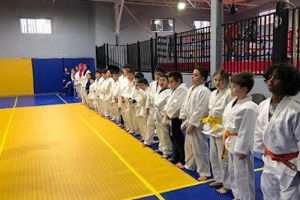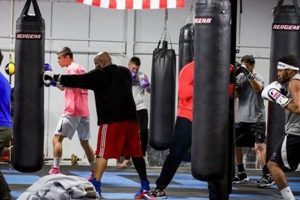Mixed martial arts training in the District of Columbia provides individuals with opportunities to learn self-defense techniques, improve physical fitness, and engage in a challenging sport. This form of training combines elements of various martial arts disciplines, including boxing, wrestling, Brazilian Jiu-Jitsu, Muay Thai, and others. A typical program may involve a combination of striking drills, grappling practice, conditioning exercises, and sparring sessions.
The benefits of disciplined martial arts training extend beyond physical prowess. It can cultivate mental discipline, enhance focus, build self-confidence, and foster a sense of community among participants. The growth of mixed martial arts as a spectator sport and its increasing popularity as a fitness activity have contributed to a rise in the number of training facilities available in urban centers like Washington, D.C. This has made it more accessible to individuals of different backgrounds and skill levels.
This article will further explore various aspects of mixed martial arts training in Washington, D.C., covering topics such as choosing the right gym, the benefits of different training styles, and potential career paths for dedicated practitioners.
Tips for Choosing Mixed Martial Arts Training in Washington, D.C.
Selecting the right training environment is crucial for maximizing one’s potential in mixed martial arts. Careful consideration of several factors can contribute significantly to a positive and productive training experience.
Tip 1: Research gym reputations and instructor credentials. Thoroughly investigate the backgrounds and experience of instructors. Look for certified trainers with proven track records in coaching and competition.
Tip 2: Visit different facilities and observe classes. Assess the training environment, observe instructor-student interactions, and get a feel for the overall atmosphere. A supportive and respectful environment is essential for effective learning.
Tip 3: Consider class schedules and location convenience. Ensure the gym’s schedule aligns with personal commitments and that the location is easily accessible.
Tip 4: Evaluate the gym’s equipment and facilities. Adequate training equipment, clean facilities, and appropriate safety measures are essential for a productive and safe training experience.
Tip 5: Inquire about trial periods or introductory offers. Taking advantage of trial periods allows prospective students to experience the training firsthand before committing to a long-term program.
Tip 6: Determine the gym’s focus and specialization. Some gyms may emphasize specific disciplines within mixed martial arts. Aligning training with individual goals is crucial for achieving desired outcomes.
Following these guidelines can help individuals identify a training program that aligns with their individual needs and goals, leading to a more fulfilling and successful experience in mixed martial arts.
By carefully considering these factors, individuals can make informed decisions about their training, ultimately maximizing their potential and achieving their desired results within the challenging and rewarding world of mixed martial arts.
1. Gym Reputation
A gym’s reputation significantly impacts the quality of mixed martial arts training in Washington, D.C. Prospective students should carefully consider a gym’s standing within the community before committing to a program. A strong reputation often reflects high-quality instruction, effective training methodologies, and a positive learning environment.
- Instructor Expertise:
Reputable gyms often employ experienced and certified instructors with proven track records in coaching and competition. This expertise translates into effective training programs that cater to diverse skill levels, from beginners to advanced practitioners. For example, a gym known for producing successful amateur or professional fighters likely possesses strong coaching expertise. This benefits all students, providing access to high-quality instruction and mentorship.
- Training Environment:
A gym’s reputation also reflects the overall training environment. A positive and supportive atmosphere fosters learning and encourages camaraderie among students. Gyms known for their welcoming and inclusive environments attract diverse individuals, creating a rich training experience. Conversely, a gym with a reputation for negativity or exclusivity can hinder a student’s progress and overall enjoyment.
- Facilities and Equipment:
Well-maintained facilities and up-to-date equipment are crucial for effective training. A gym’s reputation often reflects the quality of its infrastructure. Gyms known for investing in their facilities demonstrate a commitment to providing students with the best possible training resources. Adequate mat space, functional equipment, and clean facilities contribute to a safe and productive learning environment.
- Student Success Stories:
The success of a gym’s students is a strong indicator of its overall quality. Reputable gyms often showcase the achievements of their students, whether in competitions, fitness transformations, or personal growth. These success stories provide prospective students with tangible evidence of the gym’s effectiveness. For instance, a gym with numerous student testimonials highlighting positive experiences and skill development signifies a strong track record.
Ultimately, a gym’s reputation offers valuable insights into the quality of training provided. Thorough research, including online reviews, testimonials, and visits to potential gyms, allows prospective students to make informed decisions and choose a training environment conducive to their individual goals and aspirations within the Washington, D.C., mixed martial arts community.
2. Instructor Credentials
Instructor credentials represent a critical factor in the quality of mixed martial arts instruction within Washington, D.C. Certified instructors possessing recognized qualifications and proven experience offer structured learning environments conducive to skill development. Credentials from established organizations, such as recognized coaching certifications and documented competitive experience, often indicate a commitment to professional development and adherence to established training methodologies. This structured approach benefits students by providing a framework for progression and a higher standard of instruction. For example, an instructor with a black belt in Brazilian Jiu-Jitsu and a proven coaching record offers a level of expertise that enhances the learning experience for students of all levels.
The impact of qualified instructors extends beyond technical skill development. Experienced coaches understand the nuances of training, including injury prevention, appropriate progression, and individualized instruction. This nuanced approach fosters a safe and effective training environment. Furthermore, certified instructors often adhere to ethical guidelines and professional standards, contributing to a positive and respectful training culture. This can be particularly important in a contact sport like mixed martial arts, where safety and respect are paramount. Consider a scenario where an instructor without proper credentials pushes a student too hard, resulting in injury. This not only harms the student but also reflects poorly on the training environment. Conversely, a qualified instructor understands how to tailor training to individual needs and limitations, mitigating risks and promoting long-term progress.
In summary, instructor credentials serve as a crucial indicator of quality within the Washington, D.C., mixed martial arts landscape. Prioritizing training under qualified professionals ensures access to structured learning environments, effective training methodologies, and a commitment to safety and ethical practices. This, in turn, contributes to a more positive, productive, and ultimately successful training experience for individuals pursuing mixed martial arts.
3. Training Environment
The training environment significantly influences the effectiveness and overall experience of mixed martial arts classes in Washington, D.C. A positive and productive atmosphere fosters learning, encourages growth, and contributes to student retention. Several key elements comprise an optimal training environment, impacting both individual progress and the collective experience.
Safety and Cleanliness: A safe and clean facility is paramount. Proper mat hygiene, well-maintained equipment, and adequate ventilation contribute to a healthy training space. Neglecting these aspects can lead to injuries and the spread of infections, disrupting training and potentially discouraging continued participation. For example, a poorly maintained training surface increases the risk of skin infections, while faulty equipment can lead to more serious injuries. Conversely, a clean and well-equipped facility demonstrates a commitment to student well-being, fostering trust and encouraging consistent attendance.
Culture of Respect and Support: A respectful and supportive training culture cultivates camaraderie and encourages growth. Constructive feedback, mutual encouragement, and an inclusive atmosphere create a positive learning experience for practitioners of all levels. This positive dynamic promotes consistency and allows individuals to push their boundaries without fear of judgment or negativity. In contrast, an environment characterized by negativity, intimidation, or excessive ego can hinder progress and create a sense of discomfort, potentially leading to student attrition.
Structured Curriculum and Coaching: A well-defined curriculum delivered by qualified instructors provides a framework for learning and progression. Clear expectations, individualized instruction, and progressive skill development contribute to a sense of accomplishment and motivate continued training. A structured approach ensures that students acquire fundamental skills before progressing to more advanced techniques, minimizing frustration and maximizing long-term development.
In summary, the training environment plays a crucial role in the success and sustainability of mixed martial arts programs in Washington, D.C. A safe, supportive, and structured environment cultivates positive learning experiences, encourages consistent training, and contributes to the overall growth and development of practitioners. Addressing potential challenges, such as maintaining hygiene standards or fostering a respectful training culture, directly impacts the quality and effectiveness of mixed martial arts instruction, ultimately shaping the experiences of those seeking to engage in this demanding yet rewarding discipline.
4. Class Schedules
Class schedules constitute a critical factor influencing accessibility and participation in mixed martial arts training within Washington, D.C. Diverse scheduling options accommodate varying lifestyles and commitments, enabling a broader range of individuals to pursue training. A gym offering classes throughout the day, including early morning, midday, evening, and weekend sessions, caters to diverse schedules, from working professionals to students and stay-at-home parents. Conversely, limited scheduling options can restrict access, potentially excluding individuals with inflexible commitments. For instance, a gym offering only evening classes may exclude individuals working late shifts or those with childcare responsibilities during those hours. The availability of varied class times directly impacts the potential student population a gym can reach.
Furthermore, the frequency and duration of classes influence training consistency and progress. Frequent classes allow for regular practice, promoting skill development and physical conditioning. Offering shorter, high-intensity sessions alongside longer, more comprehensive classes caters to different training goals and time constraints. A student aiming for competitive training might prioritize longer sessions focusing on specific techniques, while someone seeking general fitness might opt for shorter, high-intensity workouts. The strategic scheduling of classes allows individuals to tailor their training regimens to their specific needs and objectives, maximizing the effectiveness of their time commitment. Consider a student working full-time who can only dedicate an hour to training twice a week. Access to appropriately scheduled classes allows this individual to maintain consistent training despite time constraints.
In conclusion, carefully planned class schedules contribute significantly to the accessibility and effectiveness of mixed martial arts training in Washington, D.C. A diverse schedule accommodating various lifestyles and preferences maximizes participation, while offering varying class durations and frequencies allows individuals to optimize their training based on individual goals and available time. Effectively addressing scheduling considerations ensures broader access to mixed martial arts training, contributing to the growth and vibrancy of the local martial arts community.
5. Program Costs
Program costs represent a significant factor influencing access to and participation in mixed martial arts training within Washington, D.C. Understanding the various cost structures and payment options associated with local training programs enables prospective students to make informed decisions aligned with their budgets and training goals. Varying program costs reflect differences in gym amenities, instructor experience, class frequency, and program duration. Careful consideration of these cost components ensures a worthwhile investment in training.
- Membership Fees:
Membership fees typically cover access to gym facilities, equipment, and a range of classes. These fees can vary significantly based on gym location, amenities offered, and contract duration. For example, a gym located in a prime location with state-of-the-art equipment may command higher membership fees than a smaller, more basic facility. Furthermore, longer-term contracts often offer discounted rates compared to month-to-month memberships. Understanding these variations allows individuals to select a membership structure aligned with their budget and training frequency.
- Class Packages:
Some gyms offer class packages as an alternative to traditional memberships. These packages typically involve purchasing a set number of classes at a discounted rate. Class packages provide flexibility for individuals who cannot commit to regular training schedules or prefer to explore different gyms before committing to a membership. A student traveling frequently for work might benefit from a class package, allowing them to train sporadically without the obligation of a recurring membership fee. Comparing the per-class cost of packages versus memberships enables informed decision-making based on individual training patterns.
- Private Lessons:
Private lessons provide personalized instruction tailored to individual needs and goals. While generally more expensive than group classes, private lessons offer focused attention from experienced instructors, accelerating skill development and addressing specific technical challenges. An individual preparing for an amateur competition might invest in private lessons to refine techniques and develop personalized strategies. Evaluating the cost of private lessons against the potential benefits, such as accelerated progress and individualized coaching, helps determine their value within a comprehensive training plan.
- Additional Costs:
Beyond core training costs, additional expenses may include equipment purchases, competition fees, and travel expenses. Factoring in these potential costs provides a realistic assessment of the overall financial commitment associated with mixed martial arts training. A student requiring specialized equipment, such as sparring gloves or protective gear, must account for these expenses within their budget. Similarly, individuals interested in competing should consider registration fees, travel costs, and potential coaching expenses associated with competition preparation.
Considering all aspects of program costs, from membership fees to additional expenses, empowers individuals to make informed decisions about mixed martial arts training in Washington, D.C. Understanding cost structures enables prospective students to select programs aligned with both their financial resources and training objectives, ensuring a sustainable and rewarding martial arts journey.
Frequently Asked Questions about Mixed Martial Arts Training in Washington, D.C.
This section addresses common inquiries regarding mixed martial arts training in Washington, D.C. Providing clear and concise answers aims to offer prospective trainees a comprehensive understanding of the training landscape.
Question 1: What is the average cost of mixed martial arts classes in Washington, D.C.?
Costs vary based on factors such as gym location, program specifics, and instructor experience. Prospective trainees are encouraged to contact gyms directly to inquire about current pricing structures and available options.
Question 2: How often should one train to see noticeable improvements in mixed martial arts?
Training frequency depends on individual goals and available time. Consistent training, ideally two to three times per week, is generally recommended for observable progress. Consulting with instructors can help individuals establish realistic training schedules aligned with their objectives.
Question 3: Is prior experience in martial arts necessary to begin mixed martial arts training?
Prior experience is not a prerequisite. Many gyms offer introductory programs designed for beginners. These programs focus on fundamental techniques and gradually introduce more advanced concepts as students progress.
Question 4: What type of equipment is typically required for mixed martial arts training?
Equipment requirements vary by gym and training level. Basic equipment typically includes hand wraps, boxing gloves, shin guards, and appropriate athletic attire. Gyms often provide some equipment, while other items may require individual purchase.
Question 5: How can one find reputable mixed martial arts gyms in Washington, D.C.?
Researching online reviews, seeking recommendations from experienced practitioners, and visiting gyms in person can assist individuals in identifying reputable training facilities aligned with their needs and preferences. Observing classes and speaking with instructors can provide valuable insights into training methodologies and gym culture.
Question 6: What are the primary benefits of mixed martial arts training beyond self-defense?
Mixed martial arts training offers numerous benefits beyond self-defense, including improved physical fitness, increased discipline, enhanced mental focus, stress reduction, and the development of valuable life skills such as perseverance and resilience.
Understanding these key aspects of mixed martial arts training can assist individuals in making informed decisions about their training journey. Thorough research and direct communication with potential gyms ensures the selection of a training program aligned with individual goals and preferences.
The next section will explore specific training programs offered by various mixed martial arts gyms in the Washington, D.C. area.
Mixed Martial Arts Training in Washington, D.C.
This exploration of mixed martial arts training opportunities in Washington, D.C., has highlighted key considerations for prospective trainees. Factors such as gym reputation, instructor credentials, training environment, class schedules, and program costs contribute significantly to a positive and productive training experience. Careful consideration of these elements empowers individuals to select programs aligned with individual needs and aspirations. From researching gym reputations to evaluating program costs, informed decision-making is crucial for embarking on a fulfilling martial arts journey.
The diverse landscape of mixed martial arts training in Washington, D.C., offers a pathway to self-improvement, physical empowerment, and personal growth. The pursuit of mixed martial arts cultivates discipline, resilience, and a profound sense of self-efficacy, extending beyond the gym and enriching lives in multifaceted ways. Potential trainees are encouraged to explore available options, visit local gyms, and engage with experienced practitioners to discover the transformative potential of mixed martial arts.







